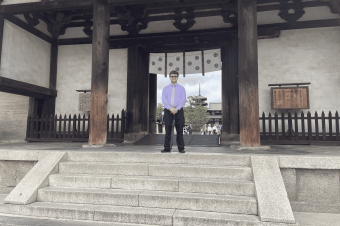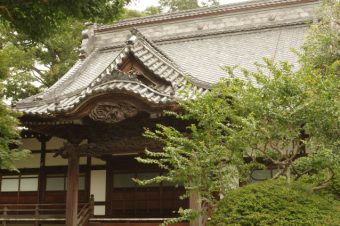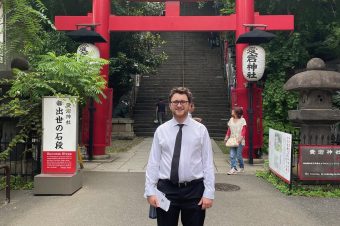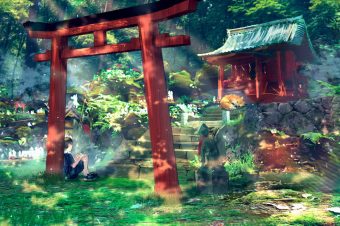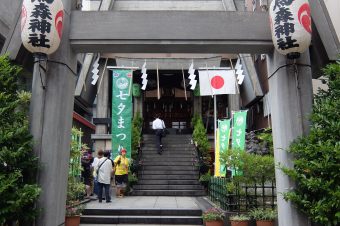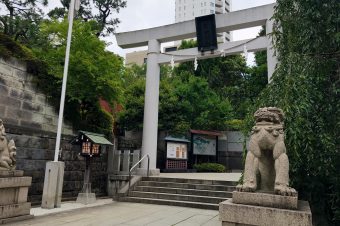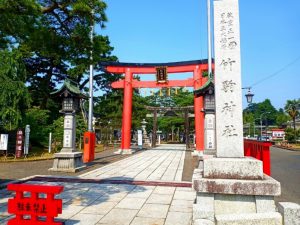
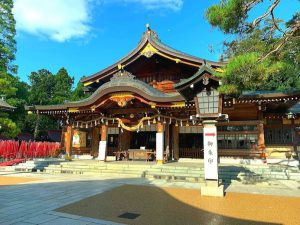
The Takekoma Inari Shrine, located in the city of Iwanuma in Miyagi Prefecture, Japan, was having a special event on Saturday, June 18th, 2022. For the first time ever, they were hosting a special camping event where people could learn basic, outdoor survival skills, and worship the kami Inari (the Japanese god of foxes, fertility, rice, tea and sake, agriculture, industry, general prosperity and worldly success). The following day would consist of a diverse morning market and a taiko (a traditional Japanese drum) band.
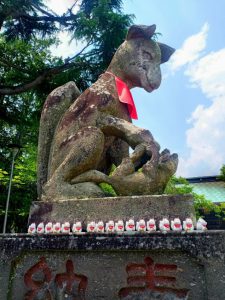
Takekoma Inari Shrine is considered to be one three main shrines dedicated to the kami Inari, and it is also said to be the second oldest Inari shrine in all of Japan. Above is a picture I took of the statue of a fox playing with their cub. This shows me the kami Inari is a loving and nurturing god, not one to be feared, but to be respected. This fox at the entrance is considered a komainu (a shrine guardian, usually dog, lion or fox, depending on the kami they serve), which comes in a pair of two.
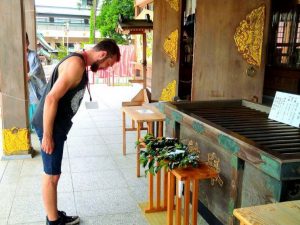
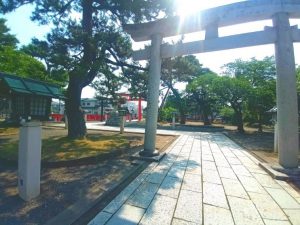
The event started with a gathering of everyone at the front of the shrine for a prayer. We took turns approaching the shrine and praying in the traditional Shinto manner, by bowing twice, clapping our hands twice, praying, then bowing one more time. During the time the priest was speaking, everyone was in sync with their bowing and clapping, it was simply astonishing; it was as if everyone was singing the lyrics to the same song.
After we had prayed and worshipped the kami Inari, we headed back for to our tents to collect ourselves before we went into Boy Scout mode. About 15 minutes later, we were summoned to the center of our campsites by our instructor in order to learn our first skill, pitching a tent.
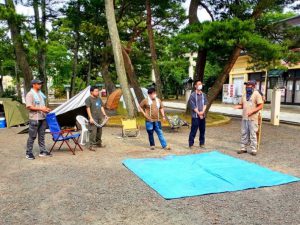
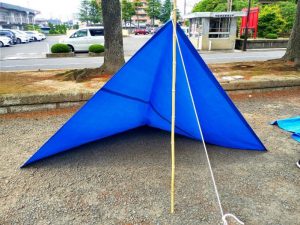
The tent pitching lesson started out simple with our instructor teaching us how to tie a couple of basic knots. After everyone was able to use their knot to tie it to something, we moved on to the next steps. The instructor provided us with a square tarp, a stick of bamboo, a hammer and a four pack of metal tent stakes.
We started it out by laying the square tarp on the ground and hammering a stake into the back corner. Then we gave some leeway to the left and right corners of the tarp, pushing them slightly inwards and hammering stakes into them too. After we completed these steps, we needed hammer our fourth stake at a fair distance in from the front corner of our tent. We would use this fourth stake to tie our rope onto, using the knot lessons which we learned earlier.
Once we had attached the rope securely to the stake, it was time to use the rope to connect the stake to the bamboo stick, and the bamboo stick to the front corner of the tent. Once we attached everything together, it was time to make sure our tent was tight, secure, adjustable and balanced. I was lucky enough to pitch my tent correctly the first try, but some of the other campers had to readjust their tents, and some even had to restart it completely. Camping is fun, that is for sure, but it is not always easy.
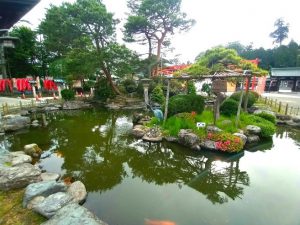
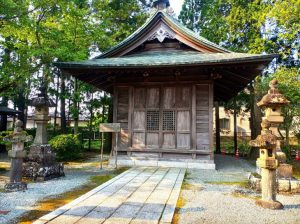
After our satisfactorily educational lesson in pitching a tent, we were given another break. I used my time to walk around the shrine, and take pictures of the beautiful scenery around. There was good size pond which contained koi fish, and was surrounded by stone lanterns, statues and natural beauty. There was also a smaller wooden building which is said to be the sacred warehouse. The thought of the history behind these sites alone was beyond fascinating to me.
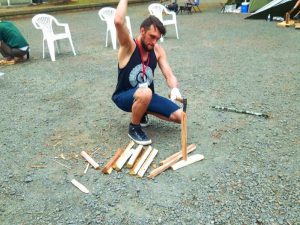
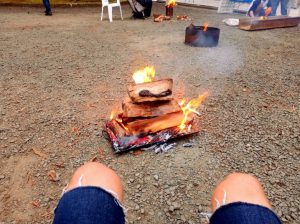
Before I knew it, we were being summoned back to the center of the campsite. Our next lesson in camping was setting up a campfire. We campers were instructed to gather four logs (two hardwood logs & two softwood logs). After finding a few good logs, we were told to begin chopping the soft wood logs, with an axe, using the hardwood log as a hammer.
We started by chopping the softwood logs in half, then in quarters, then in eighths, and so on until we had tinder wood of different sizes and shapes. I began chopping, and after about 10 or 15 minutes, I had a satisfactory amount of tinder.
Our instructor handed us pieces of newspaper which we loosely rolled and tied into a knot; this was our base. Starting with the smaller pieces of tinder, we stacked them our wood around the newspaper like a teepee. Followed by larger and larger pieces of wood, we finally created a bundle of sticks ready to light.
With the smallest touch of a flame to the newspaper base, the fire ignited the newspaper and started growing. The flames spread to the smaller pieces of tinder, and then to the larger until eventually the whole thing was burning bright. After the sticks began losing their balance, we placed larger logs on top of them in order to keep the fire going.
After everyone had their fire set, we finished our campfire with one final lesson; we were going to cook rice. We were instructed to finish the beer we were drinking, and then rinse out the can with water. From there we poured a small bag of rice into our empty beer can and filled it to the top with water, and then seal it with the can’s tear strip. We let our rice sit for about half an hour, then we placed it in the ember of the fire to cook. After it was finished cooking, we used a log grabber to retrieve our can of rice from the heat. Once the can had cooled down enough, I used a knife to vertically slit the can open, and then I bent it to open the hole. I used my chop sticks to begin digging in, and I am not even going to lie; it was the best rice I have ever eaten.
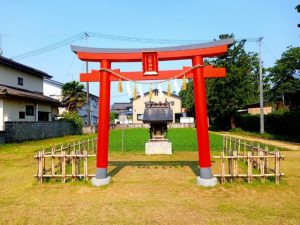
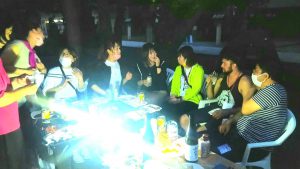
Once we finished our culinary camping lesson, we finished our camping education for the night. I did a little more walking around and found a hidden little gem across a small bridge. A torii gate (the red, arched structure in the photo above), in front of a hokora (a miniature Shinto shrine), in front of a tambo (a rice paddy). It was a very peaceful part of the Takekoma Inari Shrine, and I was glad I spotted it before I left.
After my walk around the Takekoma Inari Shrine, we retired to our campsites and began preparing a Japanese barbecue feast. I tried a lot of different meats that night; I tried tongues, intestines, liver and more. I caught a lot of my fellow campers looking at me and giggling every time I was about to try something new for the first time. I guess they were curious if an American man could get down with some cow tongue, and I could, I could definitely get down with it; cow tongue is definitely delicious, I know this now.
We shared food, beer and laughs as we sat around a grill, preparing yakiniku (grilled meat) and pouring sake for each other as per Japanese tradition; the people of Iwanuma really know how to throw a good rager. We continued our shrine camping party until we were falling asleep in our chairs, so, with our stomachs filled, we retired to our tents to prepare for the morning market.
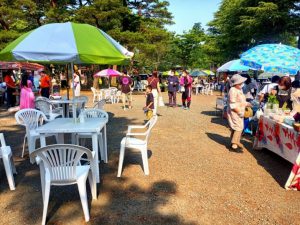
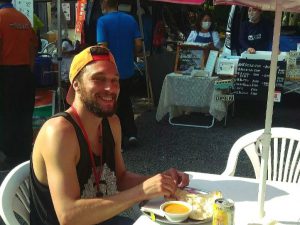
Apparently, every other Sunday the Takekoma Inari Shrine has this morning market. I woke up from my tent at around at 5:00AM to join my fellow campers having coffee from the vending machine. I went to the bathroom, and when I returned, out of absolutely nowhere, every vender had arrived and began setting up their stands for the morning market. Once again the people in this city were completely in sync, coming to the same place all at once.
I began helping to set up the morning market, putting up tables, chairs, umbrellas, hand sanitizer, etc. Then once everything was complete, I took a look around at all the different stands, and it was quite diverse. The most popular vendor was an Indian food stand which sold some of the most amazing curry I have ever indulged in (as seen in the picture above; the people running the stand were so friendly and quite kind too.
The other stands consisted of a few different fresh vegetable stands, a man selling sake from his truck, a yakitori (grilled chicken meat, usually on a stick) food truck, a couple of arts & crafts dealers, a sandwich stand and a dessert stand.
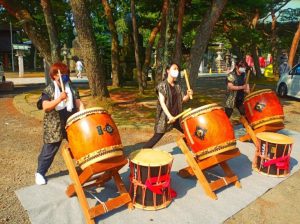
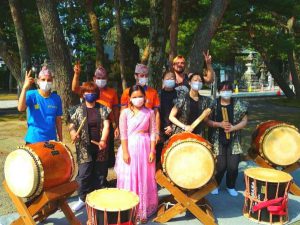
In the middle of a market there were some young ladies who began carrying large taiko about the size themselves out onto a centrically placed carpet; this was my first time seeing a taiko band. Other morning market attendees and I waited patiently for these ladies to set up their drumming arrangement and to begin playing some traditional Japanese music.
Once they were ready to begin their performance, that first pound on the taiko had the undivided attention of the entire market audience. I have also never just sat and listened to someone playing only drums, but the taiko is just so different compared to an ordinary drum set, it was enchanting, mesmerizing even, especially watching three drummers playing at once. Each musician switched off from playing the same thing to create a louder beat, then to playing different parts in order to compose a more harmonious rhythm.
This amazing band did not play nearly as long as I would have liked them to; nevertheless, they rocked the socks off of everyone at this market, and left me wanting more. I would love to see them play again the next time I am in Iwanuma; I wish I had thought to ask if their band had a Facebook page. Regardless, the owners of the portable Indian restaurant and I wanted to get our photo taken with this talented group of individuals, and this is one I will be sure to keep forever.
